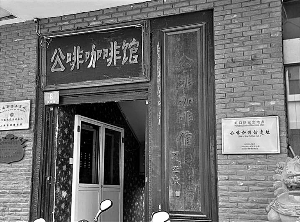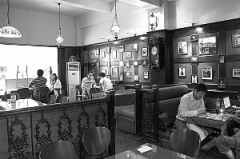Cafe meets historical celebrities

Afternoon tea at Banpo Village Cafe.

Cafe four cats, aka cafe Picasso.

Van Gogh's famous painting "Cafe at Night".

Today's coffee shop has become a cultural heritage.

Banpo village in the old days: many writers, painters, scholars have gathered here.
In addition to being suitable for love, coffee shops are also rich in creativity, inspiration, theory, etc. and everything related to ideas. This is not only because coffee itself excites people's brains and activates their spirits, but also because coffee shops have a continuous tradition.
It is said that the first coffee shop in the world was called Kiva Han, which opened in Mecca in 1475. Subsequently, coffee was introduced to Egypt, North Africa, Turkey and other Arab countries. Coffee drinking became popular, and many people gathered in cafes to drink coffee, discuss politics, and criticize the government. Coffee shops became a source of opinions and ideas.
When the first coffeehouse in Western Europe was established at Oxford University in England in 1650, coffeehouses quickly became a trend throughout Europe and soon became "open places for the exchange of ideas," where thinkers, musicians, and writers gathered to whisper or harangue. One Viennese artist said,"I am not at home, I am at the coffeehouse; if not at the coffeehouse, I am on my way to the coffeehouse."
When the cafe met these cultural people, the ideas were fired in the collision, and many world-famous paintings and ideas that ignited social change were born. The combination of coffee shops and cultural people, the huge energy bred in them is sometimes unimaginable.
France Prokop Cafe
Encounter Voltaire, Rousseau, Hugo, Balzac
Le Procope is now a calling card for Paris, France, where it was the first café to open. The cafe's connection to the culture has given it a strong legend
In the 18th century, Voltaire and Rousseau, thinkers of the European Enlightenment Movement, and Diderot, author of the world's first encyclopedia, wrote books here that influenced the revolution and social development process in Europe and America; Robespierre, Danton and Marat, the three giants of the French Revolution, also talked with other revolutionaries about the ideal of changing society and described their own blueprints; Napoleon is said to have come here and left his military cap for drinking coffee in arrears; Later, here gathered a group of writers, actors, gentlemen and ladies of the same weight, such as Hugo, Balzac and others.
A cafe, containing so many ups and downs, can imagine the weight of this cafe in the minds of cultural people, and later a literary journal named "Prokop."
Spain·Four Cats Cafe
Meet Picasso
Just as Procopus is to Paris, the 4 Gats Cafe is to Barcelona, with the same symbolic significance. The Four Cats Cafe has another name: Cafe Picasso. Because Picasso had been here since he was 17 years old and spent three years in poverty. At that time, Picasso always drank coffee while painting his friends into exaggerated and eccentric caricatures, and then posted them on the wall of the shop. In addition, he designed advertisements and menus for the cafe, which now has a wooden blackboard with the menu Picasso designed for the owner.
Barcelona at that time (late 1890s) is Spain's most enlightened city, some cultural people also like to meet here, they exchange ideas, collision thinking, it is in this relaxed and lively atmosphere full of new trends, Picasso came into contact with various cultural schools and trends, began his painting career, and with the help of these friends, held his first exhibition of his life, brought him a great reputation.
France·Lancasar Cafe
Meet Van Gogh
If the cafe four cats is famous for picasso and is also called "cafe picasso", it is for the same reason that the cafe lancashire in france got its other name,"cafe van gogh", which is famous for another world-famous painter, van gogh.
In 1888, Van Gogh tired of city life in Paris, came to the southern French town of Arles. In September of 1888, he checked into Lancashire Cafe, also known as the "Night Cafe" because it was open all night. Van Gogh said: "The exterior of a cafe has a balcony lit by a large gas lamp in the blue night sky and a blue sky with stars shining in one corner." I have often thought that the night is more animated and colorful than the day." Thus, the famous painting "Cafe at Night" was born.
Today, the cafe has been renamed "Van Gogh Cafe" and has become a must-see for tourists to Arles. The cafe still retains the appearance of Van Gogh's painting more than 100 years ago, and the story of Van Gogh and the cafe has become a local legend.
Shanghai, China·Coffee Cafe
Encounter Lu Xun, Tian Mei, Ding Ling and Mao Dun
In the 1920s or so, coffee shops became a cultural craze in Shanghai. Many cafes imitated Paris appeared in the French Concession and Japanese Concession. At that time, the most famous one was the coffee shop located on Toronto Road in Hongkou. During the extremely serious years of white terror, some secret meetings of the literary and artistic circles were held in the coffee shop. According to Zheng Boqi's recollection: "The coffee shop was opened by foreigners, because this place is generally not visited by Chinese people, and foreigners pay little attention to coffee drinkers, so meetings are safer." Therefore, not only the preparatory meetings of the "Left Alliance" were held many times in the coffee shop, but also other left-wing cultural groups held meetings here. Lu Xun, Tian Mei, Ding Ling and Mao Dun were all guests of honor in this coffee shop.
In mid-October 1929, the Left-wing League held its first preparatory meeting in a small room on the second floor of the coffee shop, which could accommodate twelve or thirteen people. Lu Xun also attended. On February 16, 1930, the party organization held a preparatory meeting here, namely, the "Shanghai New Literature Movement Seminar". "Lu Xun Diary" contains: "afternoon with Roushi, Xuefeng out of the street to drink coffee", refers to the coffee shop to participate in the "Left Alliance" last preparatory meeting.
Banpo Village Cafe Nanjing China
Founded by painter Guo Haiping, artists, writers, poets and scholars are frequent visitors
Banpo Village Cafe and Pioneer Bookstore are two famous folk culture cards of Nanjing.
In the 1990s, painter Guo Haiping founded Banpo Village Cafe. Now it has changed hands several times, but it has always been a landmark with the most literary temperament in the city. For more than ten years, artists, writers, poets and experts and scholars at home and abroad have exchanged and talked here, taking away warmth, inspiration, creativity and so on, leaving behind the same essence.
Japanese Cafe
The only country with an official coffee festival
Dutch missionaries and merchants brought coffee to Japan around 1630, but at first the Japanese did not accept the strange drink at all. Coffee did not become popular until the Meiji Restoration, when Japanese society set off the wind of "Western learning." At the same time, cafes became a favorite place for young people and activists to meet and mingle. Japan is the only country to have an official coffee festival, which is celebrated every year on October 1.
Coffee houses in the United Kingdom
laid the foundation for the earliest publishing industry.
Europe's first coffeehouse appeared in Oxford University in 1650, opened by a Lebanon Jew. Cafes sprang up in London, and by 1700 there were more than 2000. As the earliest place to provide equal communication and dialogue for the public, coffeehouses in Britain were very popular. They laid a solid foundation for the earliest publishing industry. Dryden's coffee parties at Weir's Café established the standard of literary appreciation that spread from Weir's Café to the literary world, and the free debate in the Café was the base of early middle-class media such as Light, Spectator, and Guardian, when editors of these newspapers sat in cafes all day listening to what was said there, learning about social trends, and putting them into words. Coffee houses at that time had a taste of ancient Chinese inns.
Cafe America
Like the popular fast food culture
The first coffee shop in the United States was the London Coffee Shop, which opened in Boston in 1691. Today's American cafes have their own unique form and atmosphere. Like the popular fast food culture in the United States, most American cafes also reflect a fast-paced lifestyle of American society. For example, Starbucks, which attracts young people with its unique style and atmosphere, is one of the most representative American cafes. (Photo source: Zhang Erqiu)
Important Notice :
前街咖啡 FrontStreet Coffee has moved to new addredd:
FrontStreet Coffee Address: 315,Donghua East Road,GuangZhou
Tel:020 38364473
- Prev

Coffee and numbers?
The life cycle of coffee trees is about 50 years. There are 73 coffee varieties, but only two are widely used. The oldest and finest varieties of Arabica (Arabica) and Roberta Arabica coffee are Typica (Arabica) and Bourbon (Bourbon). There are about 2250 ships engaged in coffee bean transportation around the world. There are more than 200 varieties of Arabica coffee
- Next

The encounter between Cafe and Historical celebrities
Afternoon tea at Banpo Village Cafe. The four Cat Cafe is also known as Picasso Cafe. Van Gogh's famous painting the Cafe at Night. Today's public coffee cafes have become cultural relics. The old days of Banpo Village: many writers, painters and scholars have gathered here. In addition to being suitable for romance, cafes are also rich in creativity, inspiration, theory, and so on.
Related
- How did the Salvadoran coffee industry develop in Central America?
- What exactly does the golden cup extraction of coffee mean?
- The Origin of Coffee flower
- [2023 Starbucks World Earth Day] there are more meaningful things besides free Starbucks coffee!
- What kind of coffee is there in Spain? 9 Flavors of Spanish Coffee
- Aromatic African coffee| Kenya's coffee culture and historical production area
- Liberica Coffee Bean knowledge: the characteristics of Liberian Coffee beans of the three original species of Coffee beans
- The origin and formula of Spanish latte introduces the taste characteristics of Bombon coffee in Valencia, Spain.
- How to adjust the solution of over-extracted coffee
- What is the tasting period of coffee beans? What is the period of coffee and beans? How should coffee wake up and raise beans?

